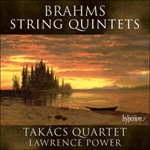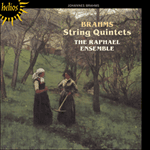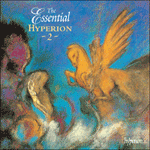
Welcome to Hyperion Records, a British classical label devoted to presenting high-quality recordings of music of all styles and from all periods from the twelfth century to the twenty-first.
Hyperion offers both CDs, and downloads in a number of formats. The site is also available in several languages.
Please use the dropdown buttons to set your preferred options, or use the checkbox to accept the defaults.

| Takács Quartet, Lawrence Power (viola)» More |
The first subject’s soaring theme generates a fine paragraph of densely scored lyricism before secondary material arrives in the form of a discourse between paired violas and the remaining instruments. The extension of this theme embodies much conscious undermining or displacement of normal accentuation, often exacerbating the effect through cadence formations whose timing produces artificial stresses on otherwise ‘weak’ beats. This habitual tendency in Brahms might be seen as arising consciously or unconsciously from choral mastery: his study of Palestrina’s (un-barred) imitative polyphony, and his own consequent flexibility in subordinating metrical rhythm to patterns of syllabic stress where appropriate, may well be the source of the richly varied accentuation and harmonic rhythms of his instrumental music.
The Allegro’s development section thrives upon the polyphonic possibilities of the medium, beginning quietly in B flat but generating an unusually intensive exploration of the first subject’s implications. As indicated before, this is something which ceases to work with adequate balance and suppleness in the majority of Brahms’s chamber works with piano, and which does not arise in the comparatively stiff and strenuous context of the three string quartets. The same felicitous touch animates a spacious recapitulation and a coda which enables the respective instruments to meditate upon past thematic material as both soloists and ensemble members, much as in an operatic set-piece (though here any operatic connection ends). A gradual withdrawal into self-communing stillness is followed by two brusque final chords.
The Adagio (in D minor) opens with two bars whose rhythmic and tonal similarity to the Adagio e lento in Mendelssohn’s Op 87 Quintet may well be significant. The two movements are comparable in general rhythmic terms throughout, as well as in overall length. Moreover, it is Mendelssohn who comes to mind as the emotional and aesthetic model for the ‘careless rapture’ of Brahms’s first movement. The memorable melodic arch opening the earlier composer’s Octet might seem to support this, though Mendelssohn stands poles apart from Brahms in terms of variety of metre and accentuation, often becoming entrapped in his own form of ‘fearful symmetry’ from which fugal habit provides the sole relief and escape.
The third movement, Un poco allegretto, is in effect an intermezzo, again resembling its Mendelssohnian counterpart with which it shares the key of G minor (as does Mozart’s Quintet K516). However, the principal theme seems loosely to echo that which opens Schubert’s ‘Unfinished’ Symphony. Its characteristic falling semitone acquires a progressively abstracted and sorrowful mien, particularly upon its return after the central G major episode’s gently unexpected modulations. The curiously indivisible mixture of the idyllic and the melancholy has more than a little in common with Dvorák, Brahms’s younger friend and colleague who by this date was more than capable of reciprocating an influence.
The final rondo starts modestly in the ‘wrong’ key of B minor. Its mood is ambivalent and embraces several curious moments of whimsy of a folk-derived nature. Again kinship with Dvorák may be discerned in the gentle ‘humoreske’ style of the opening and in its suddenly forthright sequel which establishes the tonic key. A secondary subject in triplets reinforces the note of rustic simplicity but the central passage generates an unexpectedly single-minded exploration of the first subject, again in a fashion which would have been impracticable for Brahms in most other chamber media. Upon its re-emergence the complete subject seems to have shed something of its innocence, but after a brief recapitulation of the second subject in the tonic key the principal material proves capable of further regeneration. The spirited ‘coda’ increasingly assumes the character of a Dvorák ‘polka’ or ‘galop’ such as one finds in the ‘Dumky’ Trio, Op 90.
from notes by Francis Pott © 1995
La montée du motif du premier thème engendre un paragraphe subtil d’écriture d’un lyrisme très dense suivi par l’arrivée de thèmes secondaires sous la forme d’un discours entre des altos couplés et les autres instruments. Le développement de l’Allegro trouve un réel épanouissement avec les possibilités polyphoniques de cette forme d’expression, commençant doucement en si bémol mais engendrant une exploration d’une rare intensité des implications du premier thème. Une même touche de félicité fournit l’inspiration à une ample récapitulation et à une coda qui permet aux instruments respectifs de méditer sur les thèmes déjà évoqués à la fois en tant que solistes et en tant que membres de l’ensemble.
L’Adagio débute par deux mesures dont la similarité rythmique et tonale avec l’Adagio e lento du Quintette op.87 de Mendelssohn peut sembler notable. Les deux mouvements sont comparables en termes de rythmes tout au long de l’œuvre ainsi qu’en termes de longueur totale. De plus, Mendelssohn est le premier qui vient à l’esprit en tant que modèle émotionnel et esthétique pour le «ravissement sans retenue» du premier mouvement de Brahms.
Le troisième mouvement, Un poco allegretto est en fait un intermezzo qui à nouveau ressemble à son pendant mendelssohnien avec lequel il partage la tonalité de sol mineur (de même que le Quintette de Mozart K516). Cependant, le thème principal semble vaguement faire écho à celui de l’ouverture de la Huitième Symphonie «Inachevée» de Schubert. Le caractère tombant du demi-ton acquiert progressivement une nuance abstraite et triste, surtout au moment du retour après les délicates et inattendues modulations du passage central en sol majeur.
Le rondo final débute modestement dans la «fausse clé» de si mineur. Son caractère ambivalent embrasse plusieurs moments étranges dérivés de la musique traditionnelle. On peut discerner certaines affinités avec Dvorák dans le style «humoreske» délicat de l’ouverture et dans sa suite soudainement directe qui établit la clé tonique. Un thème secondaire en triolets renforce la simplicité rustique mais le passage central engendre une exploration du premier sujet dont la ténacité est inattendue. Au moment de sa réapparition, le thème complet semble avoir quelque peu perdu de son innocence, mais après une brève récapitulation du second thème dans la clé tonique, la matière principale se révèle capable d’une nouvelle régénération.
extrait des notes rédigées par Francis Pott © 1995
Français: Alexandre Blanchard
Die aufsteigende Melodie des ersten Themas vermittelt einen feinen Hauch dichtinstrumentierter Lyrik, ehe das sekundäre Material in Gestalt eines Diskurses zwischen einem Viola-Paar und den restlichen Instrumenten ausgedrückt wird. Die Entwicklung der Allegro-Sektion gedeiht auf den polyphonischen Möglichkeiten des Mediums. Sie beginnt leise in B, erzeugt jedoch eine ungewöhnlich intensive Erforschung der Aspekte des ersten Themas. Der gleiche glückliche Hauch inspiriert eine ausschweifende Reprise und eine Koda, die den einzelnen Musikern ermöglicht, über das vorherige thematische Material als Solisten wie auch als Mitglieder eines Ensembles zu meditieren.
Das Adagio beginnt mit zwei Takten, deren rhytmische und tonale Ähnlichkeit zum Adagio e lento in Mendelssohns Quintett op. 87 sehr wohl bedeutend sein mag. Die beiden Sätze sind im ganzen vom allgemeinen rhytmischen Ausdruck her, sowie in ihrer gesamten Länge vergleichbar. Zudem ist es Mendelssohn, der ins Auge fällt als emotionales und ästhetisches Modell für das „unbekümmerte Entzücken“ in Brahms’ ersten Satz.
Der dritte Satz, Un poco allegretto, ist praktisch ein Intermezzo, das wieder seinem mendelssohnschen Gegenstück ähnlich ist, denn beide beinhalten die Tonart g-Moll (so auch Mozarts Quintett, K516). Die Hauptmelodie scheint jedoch leicht jene wiederzugeben, die Schuberts unvollendete achte Sinfonie eröffnet. Ihr charakteristisch fallender Halbton nimmt eine verstärkt abstrakte und trauergefüllte Miene an, besonders bei ihrer Rückkehr nach der zentralen Episode in G-Dur mit ihren sanften, unerwarteten Modulationen.
Das abschließende Rondo beginnt bescheiden in der „falschen“ Tonart h-Moll. Seine Stimmung ist mehrdeutig und umfaßt zahlreiche kuriose Momente fast volksmusikalischer Natur. Die Verwandtschaft mit Dvorák ist in dem sanften „humorvollen“ Stil des Anfangs und dem die Tonart bestimmenden plötzlich unverblümten Fortsetzen, wahrzunehmen. Ein sekundäres Thema in Triolen verstärkt den Aspekt rustikaler Simplizität, die zentrale Passage jedoch bewirkt ein unerwartet beharrliches Erforschen des ersten Themas. Nach seinem Wiederauftauchen scheint das gesamte Thema etwas von seiner Unschuld verloren zu haben, nach einer kurzen Reprise des zweiten Themas in der Grundtonart beweist das Hauptmaterial seine Fähigkeit zu weiterer Regeneration.
aus dem Begleittext von Francis Pott © 1995
Deutsch: Ute Mansfeldt
 Brahms: String Quintets Brahms: String QuintetsThe Takács Quartet has been recently described as ‘one of the world’s most distinguished ensembles’. Here the players collaborate with Britain’s greatest living viola player, Lawrence Power, who has also proved himself a remarkable chamber musicia ...» More |
 Brahms: String Quintets Brahms: String Quintets‘Their playing is unerringly distinguished, and Hyperion's sonics defy criticism—a glorious offering’ (BBC Music Magazine) ‘These richly scored string quintets must rank among the finest works of Brahms's maturity … in the traditions of the best chamber music playing ...» More |
 The Essential Hyperion, Vol. 2 The Essential Hyperion, Vol. 2'More than just a highlight sampler. This is a classy collection, brought together with a great deal of care and attention to musical programming seldom found in this kind of CD … A stocking-filler any music lover would appreciate' (Scotland ...» More |

